What Shocks Are For ...
#1
Here's a short article that is one shock expert's view on the basics of shock tuning.
Here's the key point
'In recent times it was popular to valve shocks with lots of rebound and very little compression to allow a team to make small shock adjustments that the driver could feel and thereby, supposedly, achieve a good balance. Unfortunately, this approach is sure to take away grip. Simply put, compression helps keep the tire on the racing surface, rebound keeps it off the racing surface. If the shocks are so stiff as to significantly affect balance, they are too stiff to accomplish their primary job: assist in minimizing tire force variation. Further, lots of rebound does not allow the suspension to droop. In cornering, high rebound and low compression forces move the roll center toward the inside tire contact patch causing undesirable if not unpredictable changes in dynamic cross weight (balance).'
http://www.shock-shop.com/Thoughts%2...k%20Tuning.htm
The issue is that, for many reasons, tuning of shocks with high rebound and low compression (for a given spring rate) is still fairly common.
This first link's info aligns well with story related at the bottom of the next link. It also more-or-less lines up with the late Carroll Smith's section on shocks in Drive to Win (his most recently published shock info).
http://farnorthracing.com/autocross_secrets6.html
It would be interesting to see the 3 in/sec compression/rebound shock forces and spring rates that the forum's Corvettes are set up with. We might learn something useful.
Here's the key point
'In recent times it was popular to valve shocks with lots of rebound and very little compression to allow a team to make small shock adjustments that the driver could feel and thereby, supposedly, achieve a good balance. Unfortunately, this approach is sure to take away grip. Simply put, compression helps keep the tire on the racing surface, rebound keeps it off the racing surface. If the shocks are so stiff as to significantly affect balance, they are too stiff to accomplish their primary job: assist in minimizing tire force variation. Further, lots of rebound does not allow the suspension to droop. In cornering, high rebound and low compression forces move the roll center toward the inside tire contact patch causing undesirable if not unpredictable changes in dynamic cross weight (balance).'
http://www.shock-shop.com/Thoughts%2...k%20Tuning.htm
The issue is that, for many reasons, tuning of shocks with high rebound and low compression (for a given spring rate) is still fairly common.
This first link's info aligns well with story related at the bottom of the next link. It also more-or-less lines up with the late Carroll Smith's section on shocks in Drive to Win (his most recently published shock info).
http://farnorthracing.com/autocross_secrets6.html
It would be interesting to see the 3 in/sec compression/rebound shock forces and spring rates that the forum's Corvettes are set up with. We might learn something useful.
Last edited by hapnermw; 07-02-2008 at 11:02 PM.
#3
What you really care about is the shock force curve up to about 3in/sec. Most of the interesting dynamic stuff happens below 3in/sec, and because for every roll there is an un-roll, the shock will pass through all the velocities below whatever peak velocity the shock sees as a result of that particular manouvre.
Spring force, of course, is not velocity sensitive.
A more interesting discussion is to see the natural frequencies of different cars and to plot shock force as a percentage of critical damping through the 0-3in/sec velocity range.
DG
http://farnorthracing.com
Spring force, of course, is not velocity sensitive.
A more interesting discussion is to see the natural frequencies of different cars and to plot shock force as a percentage of critical damping through the 0-3in/sec velocity range.
DG
http://farnorthracing.com
#4
Dennis,
I have read your web site a couple of time now. I'm curious what you would recommend me to do with my shocks. I'm 1/2 second or so behind two local autoxer's with Penske's, Steve Wynveen and Alek Tzortzis. I certainly wont blame my Koni single adjustables for the difference, but do you think there is more I should do with them? They are off the shelf sports and I believe are set up well.
Should I put them on a dyno to make sure they match left to right?
Is there anything else I could do?
Thanks,
Chris
I have read your web site a couple of time now. I'm curious what you would recommend me to do with my shocks. I'm 1/2 second or so behind two local autoxer's with Penske's, Steve Wynveen and Alek Tzortzis. I certainly wont blame my Koni single adjustables for the difference, but do you think there is more I should do with them? They are off the shelf sports and I believe are set up well.
Should I put them on a dyno to make sure they match left to right?
Is there anything else I could do?
Thanks,
Chris
#5
Le Mans Master


Member Since: Feb 2000
Location: Bedford NH
Posts: 5,708
Likes: 0
Received 1 Like
on
1 Post
Cruise-In II Veteran

Ok, here are 5 force-velocity plots we ran on our dyno. These are all Corvette rear shocks, 5 different brands, which do you think is the best, and which one actually works the best on the street and/or track? What curve do you think is the worst? What do you think causes the hysteresis in some of these curves?
Without a dyno, you are only guessing, and real world (road race and steet) has lots of greater than 3 in/sec velocities. Body roll, squat, dive, etc is the less than 3 in/sec stuff, but bumps, curbs, ripples are much greater than that and 8-10 in/sec is very common. An interesting thing is when I was at Penske last summer, it was mentioned to me that a tolerance variation of .0005 inch (yes, 1/2 a thousand) could cause 20-30 pounds (depending on the valving) on the dyno, and that is why each shock has to be tested and if not within spec, it is made to be correct. If the super quality CNC parts in a Penske can cause that kind variation, what do you think you get in a mass produced cheap imported shock? The first plot is Force-Velocity, the second is Force-displacement. There were many details that we have not discussed, but I will later (things like not holding gas pressure, leaky seals etc)
We have seen new GM T1 shocks that flat were not working (shown here):
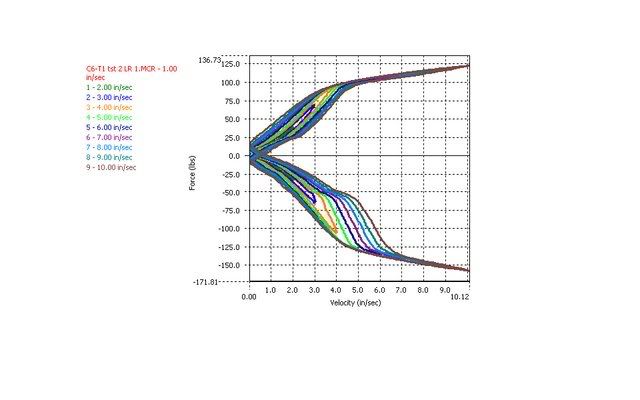

The rest are shown here, brand names deleted.
Brand A
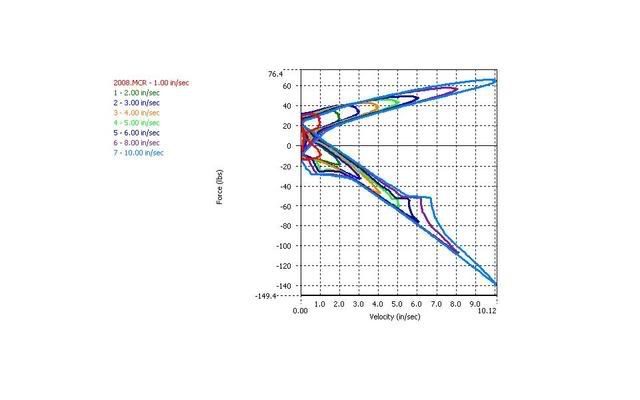
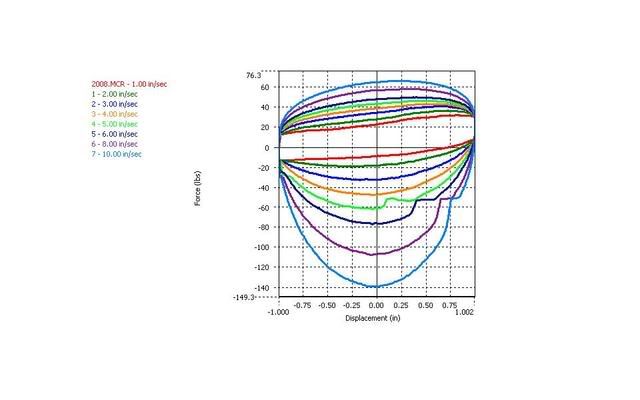
Brand B
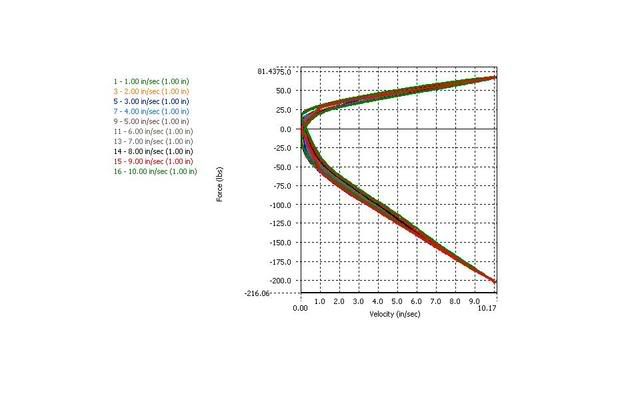
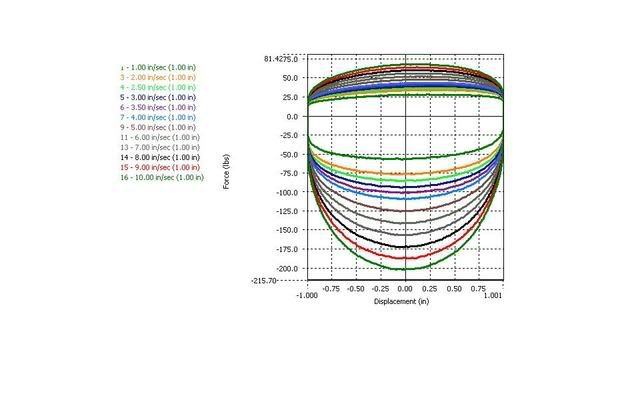
Brand C
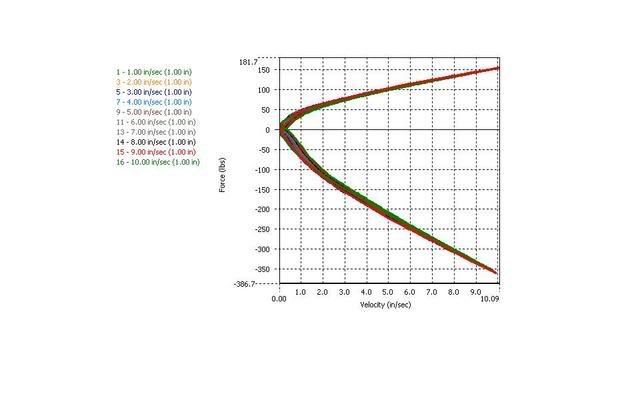

Brand D

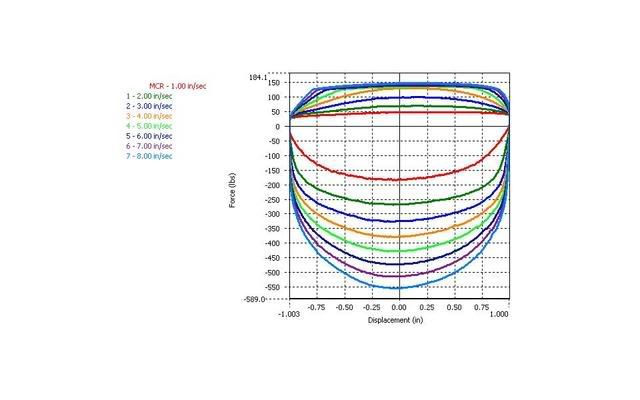
Without a dyno, you are only guessing, and real world (road race and steet) has lots of greater than 3 in/sec velocities. Body roll, squat, dive, etc is the less than 3 in/sec stuff, but bumps, curbs, ripples are much greater than that and 8-10 in/sec is very common. An interesting thing is when I was at Penske last summer, it was mentioned to me that a tolerance variation of .0005 inch (yes, 1/2 a thousand) could cause 20-30 pounds (depending on the valving) on the dyno, and that is why each shock has to be tested and if not within spec, it is made to be correct. If the super quality CNC parts in a Penske can cause that kind variation, what do you think you get in a mass produced cheap imported shock? The first plot is Force-Velocity, the second is Force-displacement. There were many details that we have not discussed, but I will later (things like not holding gas pressure, leaky seals etc)
We have seen new GM T1 shocks that flat were not working (shown here):


The rest are shown here, brand names deleted.
Brand A


Brand B


Brand C


Brand D


Last edited by ghoffman; 07-06-2008 at 10:59 AM.
#9
Melting Slicks


Member Since: Sep 2006
Location: San Mateo CA
Posts: 2,173
Likes: 0
Received 0 Likes
on
0 Posts
except for the t1 shocks (forget that they were broken), don't all of these shocks exhibit the "lots of rebound, very little compression" that http://www.shock-shop.com/Thoughts%2...k%20Tuning.htm argues against? your thoughts?
#11
Le Mans Master


Member Since: Feb 2000
Location: Bedford NH
Posts: 5,708
Likes: 0
Received 1 Like
on
1 Post
Cruise-In II Veteran

Yes! It is interesting that the only made in USA shocks that had the most miles on them still were the best. Notice how close the curves come back to the same path. That is directly related to the machining tolerances, so that the pistons donít have blowby the rings, among other things. It is a 2 way adjustable Penske 8100 so that the forces could have been (within limits) whatever I wanted them to be. Test D is a 3 way shock made in Europe and the rebound is at full hard and that could have been turned down as well to reduce the 550 pound rebound.
Dyno's don't tell the whole story but clearly they can find issues like the T1 shock that was broken and I really don't know what was going on with sample "A". Sample A made audible clunking when cycled as did the fronts from the same manufacturer. I presume it had some kind of a floater gizmo inside it, which we have seen (or heard) on KYB's.
Dyno's don't tell the whole story but clearly they can find issues like the T1 shock that was broken and I really don't know what was going on with sample "A". Sample A made audible clunking when cycled as did the fronts from the same manufacturer. I presume it had some kind of a floater gizmo inside it, which we have seen (or heard) on KYB's.
#12
Le Mans Master


Member Since: Feb 2000
Location: Bedford NH
Posts: 5,708
Likes: 0
Received 1 Like
on
1 Post
Cruise-In II Veteran

except for the t1 shocks (forget that they were broken), don't all of these shocks exhibit the "lots of rebound, very little compression" that http://www.shock-shop.com/Thoughts%2...k%20Tuning.htm argues against? your thoughts?
No, not at all. C and D have 150 pounds of bump as compared to less than half of that for the others. Keep in mind that C was at full soft on bump (compression) so that the bump forces go up from there (same can be said for D as well). This is the advantage of a 2 or 3 way adjustable shock, so that the bump forces are totally adjustable independant of the rebound. Sample A has an adjuster, but it only affected rebound and only a little bit at that.
#13
I'm 1/2 second or so behind two local autoxer's with Penske's, Steve Wynveen and Alek Tzortzis. I certainly wont blame my Koni single adjustables for the difference, but do you think there is more I should do with them?
2. It is always a good idea to dyno your shocks and see where you're at. This can shed light on what is going on - even if it is to reenforce that you're in the right ballpark.
DG







